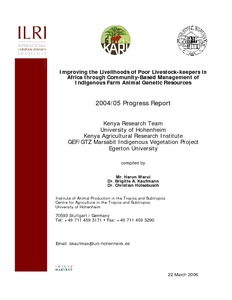Location
The Kenya Agricultural Research Institute (KARI) is a premier national institution bringing together research programmes in food crops, horticultural and industrial crops, livestock and range management, land and water management, and socio-economics. KARI promotes sound agricultural research, technology generation and dissemination to ensure food security through improved productivity and environmental conservation.
Members:
Resources
Displaying 1 - 5 of 5To mulch or to munch? Big modelling of big data
African farmers are poorly resourced, highly diverse and aground by poverty traps making them rather impervious to change. As a consequence R4D efforts usually result in benefits but also trade-offs that constraint adoption and change. A typical case is the use of crop residues as mulches or as feedstock. Here we linked a database of household surveys with a dynamic whole farm simulation model, to quantify the diversity of trade-offs from the alternative use of crop residues.
Crop residue allocation to livestock feed, soil improvement and other uses along a productivity gradient in Eastern Africa
Crop residues are a key livelihood resource in smallholder mixed crop-livestock systems in Sub-Saharan Africa. With expansion of arable land and resultant decline in grazing resources, crop residues are becoming an increasingly important component of livestock feeds. This demand for livestock feeds has implications for the long-term sustainability of such systems since failure to return biomass to soils has implications for soil quality and the capacity of soils to support long-term productivity.
Comparative description of land use and characteristics of belowground biodiversity benchmark sites in Kenya
The Kenyan below-ground biodiversity (BGBD) team selected two benchmark sites for the inventory of soil biota which were the Irangi and Ngangao forest sites located in Mount Kenya region of Embu District and the Taita Hills area of Taita Taveta District. These two sites are found in biodiversity hotspots that support rare and endemic plant and animal species. The larger Embu and Taita benchmark areas were demarcated
into sampling areas which are referred to as windows ’W’ in this study. Site characterization was carried out using the method provided by FAO-UNESCO for
Evaluation of two soil carbon models using two Kenyan long term experimental datasets
RothC and Century are two of the most widely used soil organic matter (SOM) models. However there are few examples of specific parameterisation of these models for environmental conditions in East Africa. The aim of this study was therefore, to evaluate the ability of RothC and the Century to estimate changes in soil organic carbon (SOC) resulting from varying land use/management practices for the climate and soil conditions found in Kenya.






